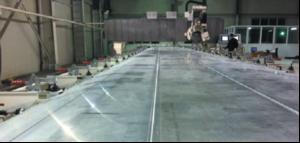

|
Edward Lowton
Editor |


|
| Home> | Production Engineering | >Welding | >Speedy welding for speedy train |
ARTICLE
Speedy welding for speedy train
25 January 2013
Installation and commissioning of a 30 x 4m gantry Crawford Swift 'Powerstir' FSW machine hs been completed by PTG Heavy Industries, in a joint project with China Friction Stir Welding Centre. The Powerstir machine ha

Installation and commissioning of a
30 x 4m gantry Crawford Swift
'Powerstir' FSW machine hs been
completed by PTG Heavy Industries,
in a joint project with China
Friction Stir Welding Centre.
The Powerstir machine has played its part in manufacturing railway car bodies similar to those used in the 'Harmony' high speed train. The machine produced what is believed to be the longest single FSW railway panel weld in China at over 15m.
In simple terms, FSW is a 'solid state' welding process which joins materials by plasticizing and consolidating the material around the joint line. No melting takes place and the final result is a fine-grained, hot-worked weld with no entrapped oxides or porosity.
With speeds to 2000mm/min, FSW is a speedy alternative to conventional welding. The process gives low distortion even in long welds, good mechanical properties - established by rigorous fatigue, tensile and bend testing - with no fumes, porosity or spatter. Energy-efficient, it produces excellent joint strength and weld appearance with no postweld grinding.
The Powerstir machine has played its part in manufacturing railway car bodies similar to those used in the 'Harmony' high speed train. The machine produced what is believed to be the longest single FSW railway panel weld in China at over 15m.
In simple terms, FSW is a 'solid state' welding process which joins materials by plasticizing and consolidating the material around the joint line. No melting takes place and the final result is a fine-grained, hot-worked weld with no entrapped oxides or porosity.
With speeds to 2000mm/min, FSW is a speedy alternative to conventional welding. The process gives low distortion even in long welds, good mechanical properties - established by rigorous fatigue, tensile and bend testing - with no fumes, porosity or spatter. Energy-efficient, it produces excellent joint strength and weld appearance with no postweld grinding.
MORE FROM THIS COMPANY
OTHER ARTICLES IN THIS SECTION

















